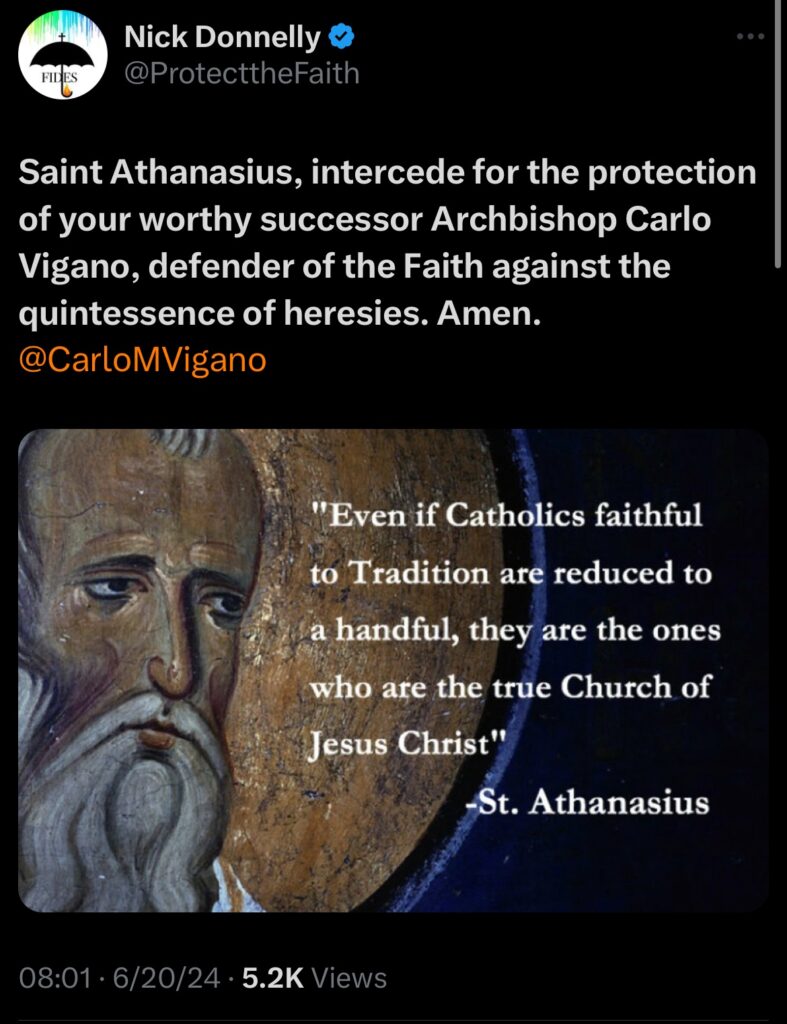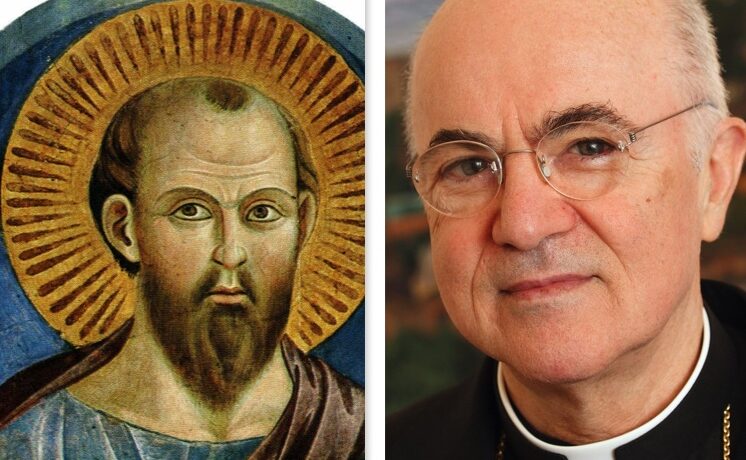Last week, Archbishop Viganó wrote this on his site:
“The Dicastery for the Doctrine of the Faith has informed me, with a simple email, of the initiation of an extrajudicial penal trial against me, with the accusation of having committed the crime of schism and charging me of having denied the legitimacy of ‘Pope Francis’ of having broken communion ‘with Him’ and of having rejected the Second Vatican Council. I have been summoned to the Palace of the Holy Office on June 20, in person or represented by a canon lawyer. I assume that the sentence has already been prepared, given that it is an extrajudicial process. I regard the accusations against me as an honor. I believe that the very wording of the charges confirms the theses that I have repeatedly defended in my various addresses. It is no coincidence that the accusation against me concerns the questioning of the legitimacy of Jorge Mario Bergoglio and the rejection of Vatican II: the Council represents the ideological, theological, moral, and liturgical cancer of which the Bergoglian ‘synodal church’ is the necessary metastasis.”
This event will certainly go down in world history. Furthermore, I’m sure Church history will side with Archbishop Viganó. I would like to defend him on a hundred issues right now, but I am going to limit my defense of him to one specific criticism: Some traditional priests (the very ones who should be defending him) tend to say: “Archbishop Viganó is just a johnny-come-lately to tradition.” Instead of welcoming him to the traditional sacraments and the battle against the modernists, some traditional priests sideline him. But it’s a silly criticism they launch, as Archbishop Viganó already admitted he was late to the party:
“To bear witness to corruption in the hierarchy of the Catholic Church was a painful decision for me, and remains so. But I am an old man, one who knows he must soon give an accounting to the Judge for his actions and omissions, one who fears Him who can cast body and soul into hell. A Judge who, even in his infinite mercy, will render to every person salvation or damnation according to what he has deserved. Anticipating the dreadful question from that Judge — ‘How could you, who had knowledge of the truth, keep silent in the midst of falsehood and depravity?’ — what answer could I give?”
Saul of Tarsus was once asked by Our Lord not only why he was persecuting His Church, but rather why Saul was persecuting Christ Himself in persecuting His Church: And falling to the ground, he heard a voice saying to him, “Saul, Saul, why are you persecuting Me?” And he said, “Who are You, Lord?” And He said, “I am Jesus, whom you are persecuting. But rise and enter the city, and you will be told what you are to do.”—Acts 9:4-6. So also, Viganó recognized (however late in life) that Christ was being re-crucified by modernists in the current Church crisis: “I do not say it will be easy to decide between silence and speaking. I urge you to consider which choice– on your deathbed, and then before the just Judge — you will not regret having made.”—Archbishop Viganó.
Saul of Tarsus became St. Paul, but he kept it ever before him that he once persecuted Christians: I thank Him who has given me strength, Christ Jesus our Lord, because He judged me faithful, appointing me to His service, though formerly I was a blasphemer, persecutor, and insolent opponent. But I received mercy because I had acted ignorantly in unbelief, and the grace of our Lord overflowed for me with the faith and love that are in Christ Jesus.—1 Tim 1:12-14. St. Paul also realized the Jewish hierarchy of his day (of whom he used to be a great leader) was deceiving new Christians to divert from the truth of the Gospel: O foolish Galatians! Who has bewitched you? It was before your eyes that Jesus Christ was publicly portrayed as crucified. Let me ask you only this: Did you receive the Spirit by works of the law or by hearing with faith? Are you so foolish? Having begun by the Spirit, are you now being perfected by the flesh?—Gal 1:1-3.
So also, our former Apostolic Nuncio to the USA, once himself caught up in the legalism of canon law and the good-ole-boys club of the bishops and Cardinals, has now turned to the ancient and unchanging Gospel to save his soul. While St. Paul learned he had to resist the hierarchy of the old religion (promoting the errors of believing Christ did not fulfill the Old Testament) so now we see Viganó resist the heretical hierarchy of the new religion—that sect which he calls the “counterfeit Church” promoting “the so-called ‘post-conciliar magisterium,’ in particular in matters of collegiality, ecumenism, religious freedom, the secularity of the State, and the liturgy.” Both St. Paul and Archbishop Viganó ultimately had to come to the same conclusion: Jesus Christ is the same: Yesterday and today and forever.—Heb 13:8. (Iesus Christus heri et hodie, ipse et in saecula.)

